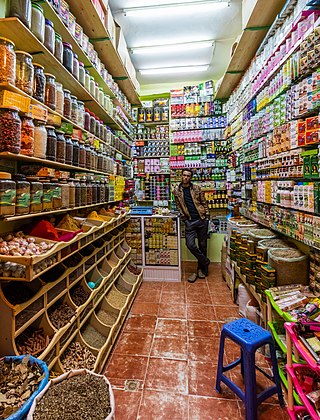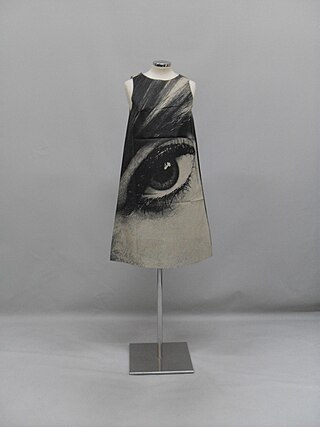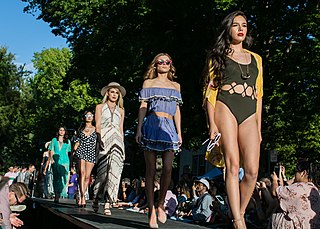Related Research Articles

Fashion is a term used interchangeably to describe the creation of clothing, footwear, accessories, cosmetics, and jewellery of different cultural aesthetics and their mix and match into outfits that depict distinctive ways of dressing as signifiers of social status, self-expression, and group belonging. As a multifaceted term, fashion describes an industry, styles, aesthetics, and trends.

A subculture is a group of people within a cultural society that differentiates itself from the values of the conservative, standard or dominant culture to which it belongs, often maintaining some of its founding principles. Subcultures develop their own norms and values regarding cultural, political, and sexual matters. Subcultures are part of society while keeping their specific characteristics intact. Examples of subcultures include BDSM, hippies, hipsters, goths, steampunks, bikers, punks, skinheads, gopnik, hip-hoppers, metalheads, cosplayers, otaku, otherkin, furries, hackers and more. The concept of subcultures was developed in sociology and cultural studies. Subcultures differ from countercultures.

Retail is the sale of goods and services to consumers, in contrast to wholesaling, which is the sale to business or institutional customers. A retailer purchases goods in large quantities from manufacturers, directly or through a wholesaler, and then sells in smaller quantities to consumers for a profit. Retailers are the final link in the supply chain from producers to consumers.
In marketing, market segmentation or customer segmentation is the process of dividing a consumer or business market into meaningful sub-groups of current or potential customers known as segments. Its purpose is to identify profitable and growing segments that a company can target with distinct marketing strategies.
In business, diffusion is the process by which a new idea or new product is accepted by the market. The rate of diffusion is the speed with which the new idea spreads from one consumer to the next. Adoption is the reciprocal process as viewed from a consumer perspective rather than distributor; it is similar to diffusion except that it deals with the psychological processes an individual goes through, rather than an aggregate market process.
The knowledge gap hypothesis is a mass communication theory based on how a member in society processes information from mass media differently based on education level and socioeconomic status (SES). The gap in knowledge exists because a member of society with higher socioeconomic status has access to higher education and technology whereas a member of society who has a lower socioeconomic status has less access or none at all. Since there is already pre-existing gap of knowledge between groups in a population, mass media amplifies this gap to another level. For example, television news programming targets a more affluent group who are interested in political and science news. The higher status viewer pays more attention to the serious stories and seeks out more in depth information beyond the news program. This article provides an overview of the Knowledge Gap Hypothesis and includes theoretical concepts, historical background, operationalization, narrative review, meta-analytic support, new communication technologies and competing hypotheses.
Trickle-down fashion is a model of product adoption in marketing that affects many consumer goods and services.

Consumer behaviour is the study of individuals, groups, or organisations and all activities associated with the purchase, use and disposal of goods and services. It encompasses how the consumer's emotions, attitudes, and preferences affect buying behaviour. Consumer behaviour emerged in the 1940–1950s as a distinct sub-discipline of marketing, but has become an interdisciplinary social science that blends elements from psychology, sociology, social anthropology, anthropology, ethnography, ethnology, marketing, and economics.

In economics, a luxury good is a good for which demand increases more than what is proportional as income rises, so that expenditures on the good become a more significant proportion of overall spending. Luxury goods are in contrast to necessity goods, where demand increases proportionally less than income. Luxury goods is often used synonymously with superior goods.

Diffusion of innovations is a theory that seeks to explain how, why, and at what rate new ideas and technology spread. The theory was popularized by Everett Rogers in his book Diffusion of Innovations, first published in 1962. Rogers argues that diffusion is the process by which an innovation is communicated through certain channels over time among the participants in a social system. The origins of the diffusion of innovations theory are varied and span multiple disciplines.
Technological change (TC) or technological development is the overall process of invention, innovation and diffusion of technology or processes. In essence, technological change covers the invention of technologies and their commercialization or release as open source via research and development, the continual improvement of technologies, and the diffusion of technologies throughout industry or society. In short, technological change is based on both better and more technology.

Youthquake was a 1960s cultural movement. The term was coined by Vogue magazine's editor-in-chief Diana Vreeland in 1965. Youthquake involved music and pop culture, and it changed the landscape of the fashion industry. The movement is characterized by looking to youth culture for a source of inspiration, taking dominance away from the English and Parisian couture houses.

The technology adoption lifecycle is a sociological model that describes the adoption or acceptance of a new product or innovation, according to the demographic and psychological characteristics of defined adopter groups. The process of adoption over time is typically illustrated as a classical normal distribution or "bell curve". The model calls the first group of people to use a new product "innovators", followed by "early adopters". Next come the "early majority" and "late majority", and the last group to eventually adopt a product are called "laggards" or "phobics". For example, a phobic may only use a cloud service when it is the only remaining method of performing a required task, but the phobic may not have an in-depth technical knowledge of how to use the service.

Fast fashion is the business model of replicating recent catwalk trends and high-fashion designs, mass-producing them at a low cost, and bringing them to retail quickly while demand is at its highest. The term fast fashion is also used generically to describe the products of this business model, particularly clothing and footwear. Retailers who employ the fast fashion strategy include Primark, H&M, Shein, and Zara, all of which have become large multinationals by driving high turnover of inexpensive seasonal and trendy clothing that appeals to fashion-conscious consumers.
The term "mass market" refers to a market for goods produced on a large scale for a significant number of end consumers. The mass market differs from the niche market in that the former focuses on consumers with a wide variety of backgrounds with no identifiable preferences and expectations in a large market segment. Traditionally, businesses reach out to the mass market with advertising messages through a variety of media including radio, TV, newspapers and the Web.

The following outline is provided as an overview of and topical guide to marketing:
Popular culture is generally recognized by members of a society as a set of practices, beliefs, artistic output and objects that are dominant or prevalent in a society at a given point in time. Popular culture also encompasses the activities and feelings produced as a result of interaction with these dominant objects. The primary driving forces behind popular culture, especially when speaking of Western popular cultures, are the mass media, mass appeal, marketing and capitalism; and it is produced by what philosopher Theodor Adorno refers to as the "culture industry".
Fashion forecasting began in France during the reign of Louis XIV. It started as a way of communicating about fashion and slowly transformed into a way to become ahead of the times in the fashion industry. Fashion forecasting predicts the moods of society and consumers, along with their behavior and buying habits and bases what they may release in the coming future off of the forecast. Fashion trends tend to repeat themselves every 20 years, and fashion forecasting predicts what other trends might begin with the rotation of fashion as well. Fashion forecasting can be used for many different reasons, the main reason being staying on top of current trends and knowing what your consumer is going to want in the future. This method helps fashion brands know what to expect and what to begin producing ahead of time. Top name brands and high end companies such as Vogue and Gucci even use this method to help their designers become even more informed on what is to come in the fashion industry.
The sociological theory of diffusion is the study of the diffusion of innovations throughout social groups and organizations. The topic has seen rapid growth since the 1990s, reflecting curiosity about the process of social change and "fueled by interest in institutional arguments and in network and dynamic analysis." The theory uses a case study of the growth of business computing to explain different mechanisms of diffusion.

The trickle-up effect in the fashion field, also known as bubble-up pattern, is an innovative fashion theory first described by Paul Blumberg in the 1970s. This effect describes when new trends are found on the streets, showing how innovation flows from the lower class to upper class. It is in contrast with classical theories of fashion consumption, such as those of Georg Simmel and Thorstein Veblen, who theorize that the upper classes are the ones who dictate the fashion flow.
References
- ↑ Egreen. (Apr 19th 2011). Basic Fashion Theory and Impact of Media. Available: http://egreen.umwblogs.org/literature-review/ Archived 2016-06-01 at the Wayback Machine . Last accessed 2nd Nov 2015.
- ↑ "Mass Marketing". 2012. Retrieved 2 May 2012. “Business Dictionary”
- ↑ Encyclopedia of clothing and fashion. (May 25th, 2010). Theories of fashion. Available: http://angelasancartier.net/theories-of-fashion Archived 2015-09-03 at the Wayback Machine . Last accessed 2nd Nov 2015.
- ↑ Retailing Management. 7 ed. Michael Levy and Barton A. Weitz. (2009). publisher: McGraw-Hill Irwin.
- ↑ Suzanne Greene Marshall, Mary Kefgen, Hazelle Jackson, and M. Sue Stanley (2000). Individuality in clothing selection and personal appearance (5 ed.). Prentice Hall. p. 178.
- 1 2 3 Juliet Ash, Elizabeth Wilson. (1993a). "Popular Fashion And Working Class Affluence", Chic Thrills: A Fashion Reader. Berkley and Los Angeles, California: Pandora Press. 145-153.
- ↑ Leslie Davis Burns. (1999). Section 6a. Mass Market Theory. Available: http://oregonstate.edu/instruct/aihm577/intro6a.htm . Last accessed 2nd Nov 2015.
- ↑ George B. Sproles. (1974). Fashion Theory: A Conceptual Framework. Available: https://www.acrwebsite.org/search/view-conference-proceedings.aspx?Id=5731. Last accessed 2nd Nov 2015.
- ↑ Diana Crane. (November 1999). Diffusion Models and Fashion: A Reassessment. Available: http://ann.sagepub.com/content/566/1/13.refs . Last accessed 2 November 2015.
- ↑ Marketing Theory: A Student Text. (31 March 2010). Summary and future outlook. In: Michael J Baker, Michael John Baker, Michael Saren Marketing Theory: A Student Text. 2nd ed. UK: SAGE. 160.
- ↑ Jagdish C. Bansal, Pramod Kumar Singh, Kusum Deep, Millie Pant, Atulya K. Nagar . (4 December 2012). Optimal promotional effort control policy for segment specific new product growth . In: Jagdish C. Bansal, Pramod Kumar Singh, Kusum Deep, Millie Pant, Atulya K. Nagar Proceedings of Seventh International Conference on Bio-Inspired Computing: Theories and Applications. Gwalior, India: Springer Science & Business Media. 347.